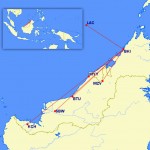![]() On Monday August 27th, 2012 the final revenue flight by an Avro 85 operated by Lufthansa Cityline occurred. This was flight LH1985 from Cologne to Munich. The aircraft type has been replaced with Embraer 190/195 aircraft in Cityline’s fleet. CityLine operated 18 93-seat Avros in a two class configuration on intercity and interregional routes within Europe. Cityline’s fleet will now consist of Embraer 190s and 195s, as well as Bombardier CRJ-700s and -900s. Cityline operates 350 daily flights to 75 destinations in 24 countries.
On Monday August 27th, 2012 the final revenue flight by an Avro 85 operated by Lufthansa Cityline occurred. This was flight LH1985 from Cologne to Munich. The aircraft type has been replaced with Embraer 190/195 aircraft in Cityline’s fleet. CityLine operated 18 93-seat Avros in a two class configuration on intercity and interregional routes within Europe. Cityline’s fleet will now consist of Embraer 190s and 195s, as well as Bombardier CRJ-700s and -900s. Cityline operates 350 daily flights to 75 destinations in 24 countries.
Aug 31 2012
Avro 85 leaves Lufthansa Cityline’s fleet
Aug 29 2012
Historical CRJ Operators – Saeaga Airlines
This is the first in an ongoing series of articles on Winglets that will summarize past airlines and other operators of CRJ aircraft that are no longer in existence.
![]() Saeaga Airlines
Saeaga Airlines
- IATA Code: SG
- ICAO Code: SGG
- Callsign: SAEAGA
- Founded: 1995
- Ceased operations: April 1998
- Hubs: Kota Kinabalu International Airport (BKI)
- Fleet size: 3
- Number of CRJs Operated: 1
Saeaga Airlines was a small regional airline which operated routes in Malaysia. The airline was established in 1995 and ceased operations in April 1998. The airline’s fleet consisted of a single Canadair Regional Jet CRJ-100ER aircraft and a pair of deHavilland Canada Dash 8-100s. Future plans for the airline at that time included leasing 10 Airbus A320s to expand its routes by September 1998 to West Malaysia (Kuala Lumpur and Langkawi) and six further destinations in China, two in Australia, as well as Hong Kong, Taiwan, the Philippines and Indonesia. The airline ceased operations in April 1998 due to the Asian financial crisis.
Airports Served
- BKI – Kota Kinabalu, Malaysia
- BTU – Bintulu, Malaysia
- KCH – Kuching, Malaysia
- MYY – Miri, Malaysia
- MZV – Mulu, Malaysia
- SBW – Sibu, Malaysia
- LAC – Layang-Layang, Malaysia
CRJ Fleet
Saeaga Airlines operated a single example of the Canadair Regional Jet in its fleet:
MSN 7089 9M-EKC (Ex C-FWRN) CRJ-100ER
This aircraft had its first flight on October 18th, 1995, and then was delivered directly to Saeaga. Following the closure of the airline, the aircraft was repossessed by Canadair and then passed through storage, being used as a demonstrator for Canadair, then as a corporate aircraft, and currently is being operated by Skywest Airlines in Delta Connection colours. As part of the transfer of this aircraft to Skywest’s fleet, the aircraft was modified to the CRJ-200ER configuration. The aircraft is currently registered as N416SW (Ex N60SR, Ex C-GDYX, Ex 9M-EKC, Ex C-FWRN)
Aug 28 2012
The History of Canadair Regional Jet MSN 7001
This is an ongoing series of articles on Winglets which track the histories of Canadair Regional Jets.
- MSN 7001
- C-FCRJ (No Other Registration Used)
- First Canadair Regional Jet Built
- Used for Flight Testing Only
- First Flight May 10, 1991
- Lost in Test Flight Accident July 26, 1993 near Wichita Kansas
Aircraft History
C-FCRJ was the first Canadair Regional Jet built. After roll out, the aircraft spent its service life testing the capabilities of the program and changes made before they were applied to other aircraft in the fleet. The aircraft was painted in a single colour scheme, that being the original CRJ program house colours. It never left the Canadair, now Bombardier, aircraft fleet and was not operated in airline service. The aircraft was lost during a flight control test over Wichita Kansas on July 26th, 1993. Three crew were lost in the accident and the aircraft was completely destroyed.
According to the accident report:
The aircraft was on a test flight out of Wichita, Kansas to evaluate flying qualities in a new 8 degree takeoff flap setting and to demonstrate compliance with US 14 CFR 25:177 rules. The aircraft lost control during a low speed steady-heading sideslip test manoeuvre at Flight Level 120. The crew were to end a Steady Heading Sideslip (SHSS) manoeuvre at a 15 degree sideslip, but continued to 21 degrees at full rudder. The plane rolled rapidly through 360 degrees and entered a deep stall. As it descended through 8000 feet the captain ordered the co-pilot to deploy the anti-spin parachute, which he complied with. The co-pilot however, didn’t close the jaws (which connect/disconnect the parachute from the airplane) before chute deployment. The parachute fell free of the plane. Control was not regained and the aircraft crashed and skidded for about 200 yards through several cornfields.
PROBABLE CAUSE: The captain’s failure to adhere to the agreed upon flight test plan for ending the test manoeuvre at the onset of prestall stick shaker, and the flight crew’s failure to assure that all required switches were properly positioned for anti-spin chute deployment. A factor which contributed to the accident was the inadequate design of the anti-spin chute system which allowed deployment of the chute with the hydraulic lock switch in the unlocked position. (When in the unlocked position, the hooks clasping the chute shackle to the airframe are open.)

 The FAA released an airworthiness directive that orders Bombardier CRJ200 operators to remove certain Goodyear main landing gear tires from service because of a wear problem that could lead to tire failures.
The FAA released an airworthiness directive that orders Bombardier CRJ200 operators to remove certain Goodyear main landing gear tires from service because of a wear problem that could lead to tire failures.

